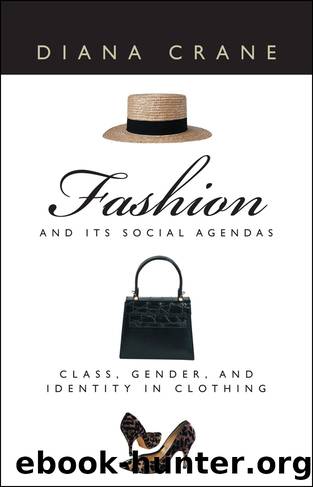Fashion and Its Social Agendas by Diana Crane

Author:Diana Crane [Crane, Diana]
Language: eng
Format: epub
Tags: History, Sociology, Feminism
ISBN: 9780226924830
Google: VT_r8GgEoKkC
Barnesnoble:
Goodreads: 765839
Publisher: University of Chicago Press
Published: 2000-01-01T00:00:00+00:00
GLOBALIZATION, INNOVATION, AND FRENCH LUXURY READY-TO-WEAR FIRMS
In the 1960s, a second group of designers, who were called créateurs, began selling low-cost, original, ready-to-wear clothing. However, in the 1970s, they entered the luxury clothing business, where they designed clothes for clients from a different social milieu than that served by the couture firms (Bourdieu and Delsaut 1975). In the 1960s and 1970s, créateurs were able to start businesses with small investments from personal funds and to expand on the basis of profits. During this period, costs of entering the business were relatively low, and designers with new small firms were able to develop reputations as innovators.10 In the 1980s, a few of these firms grew in size and profitability.
However, by the mid-1980s, new designers entering the luxury ready-to-wear business had difficulty locating venture capital as the cost of starting their firms in a global market escalated. Generally, créateursâ firms expanded by signing license agreements with industrial clothing firms or by finding sponsors willing to invest in them (Pasquet 1990). In most cases, growth was achieved by obtaining a financial sponsor, usually Japanese but occasionally Italian. French clothing manufacturers were reluctant to invest in young French designers. Financial sponsorship entailed a risk of losing control over the business if it became profitable.
Young créateurs were often unable to find sponsors and had to finance themselves (Piganeau 1998). Many firms began with very small investments, much less than the sum of $250,000 which experts considered necessary to start such a business in the 1990s (Lecompte-Boinet 1991). This usually meant that they lacked funds to expand their businesses. Costs were high, because it was necessary to use expensive fabrics in order to compete in the luxury market and also because their knowledge of the production side of the clothing business was often limited. One designer explained (Godard 1993): âI have practically no mark-up, but I produce in small quantities. The press follows my work, buyers come and they order one blouse in size 6, another in size 8, and then the same thing in another color. I lose money on practically every piece of clothing. I make my living as a stylist for a manufacturer.â
In the early 1990s, most créateur firms were small, with few employees and having annual sales of less than $10 million. Two of the three most successful créateur firms in annual sales were owned by conglomerates and were very similar in character to the large couture firms that were also owned by conglomerates. Even new firms were selling as much as 80 percent of their merchandise outside France (Guyot 1993). According to the president of a clothing firm that manufactured lines of designer clothing (Pujol 1995:46), âToday one only talks about a global market. But who can undertake the very heavy global investment necessary to introduce a designer firm simultaneously in Europe, South-East Asia, and in the United States? The investments required to start a new firm are out of proportion with the short-term profits.â
Those that survived often did so by
Download
This site does not store any files on its server. We only index and link to content provided by other sites. Please contact the content providers to delete copyright contents if any and email us, we'll remove relevant links or contents immediately.
| Advertising | Annuals |
| Book Design | Branding & Logo Design |
| Fashion Design | Illustration |
| Science Illustration |
Wonder by R.J. Palacio(8430)
Mastering Adobe Animate 2023 - Third Edition by Joseph Labrecque(3720)
Unlabel: Selling You Without Selling Out by Marc Ecko(3574)
Ogilvy on Advertising by David Ogilvy(3485)
Hidden Persuasion: 33 psychological influence techniques in advertising by Marc Andrews & Matthijs van Leeuwen & Rick van Baaren(3454)
Drawing Cutting Edge Anatomy by Christopher Hart(3440)
The Pixar Touch by David A. Price(3347)
POP by Steven Heller(3297)
The Code Book by Simon Singh(3057)
The Art of War Visualized by Jessica Hagy(2932)
Slugfest by Reed Tucker(2924)
The Curated Closet by Anuschka Rees(2897)
Rapid Viz: A New Method for the Rapid Visualization of Ideas by Kurt Hanks & Larry Belliston(2815)
Stacked Decks by The Rotenberg Collection(2796)
365 Days of Wonder by R.J. Palacio(2737)
The Wardrobe Wakeup by Lois Joy Johnson(2717)
Keep Going by Austin Kleon(2682)
Tattoo Art by Doralba Picerno(2583)
Tell Me More by Kelly Corrigan(2579)
